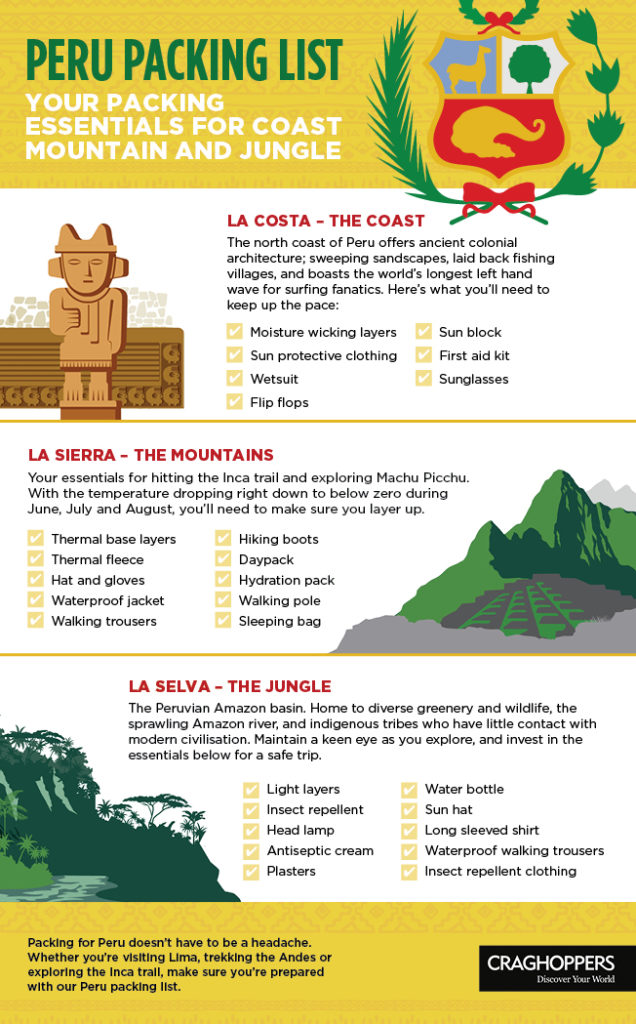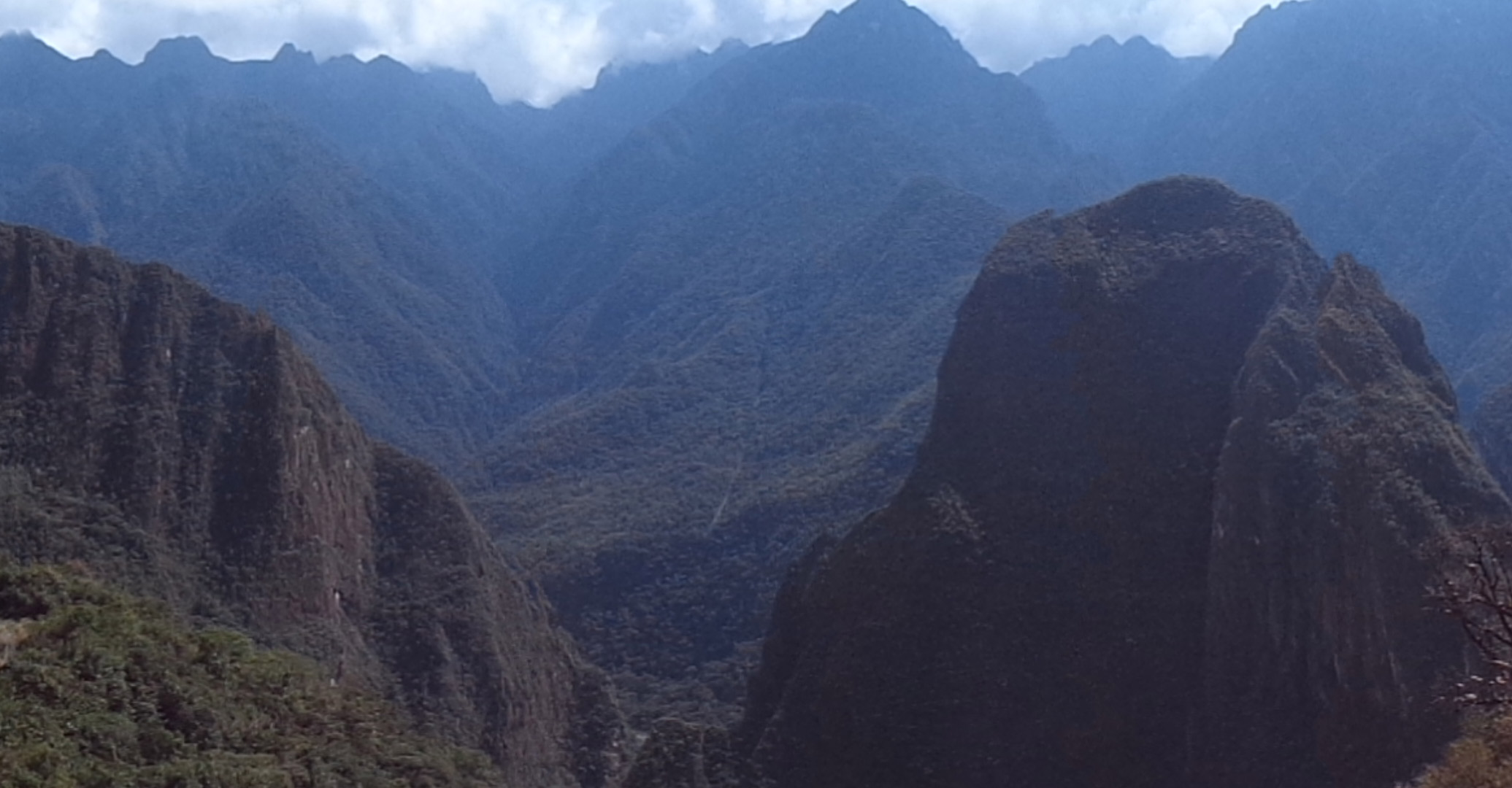Taking you via the coast, mountains, jungle and beyond. Use our Peru travel guide and accompanying Peru packing list to help you prepare for your adventure through the spectacular sights, sounds and smells of this South American gem.

Download your printable copy of our Peru Travel guide here.
La Costa
The Northern coast of Peru offers savage desert sandscapes and ancient archaeological sites, such as the historical site of Chan Chan, not to mention some of the most beautiful beaches Peru has to offer. This region of Peru is less frequently visited by tourists, but it has plenty to offer those who want to head away from the standard tourist trails.
The Ancient City Of Chan Chan
Here you’ll find the remains of the largest adobe (mud-brick walled) city in the world – created in the Chimor Empire around 1400 AD, the intricate maze of walls that span 20 square kilometres features geometric designs of fish, birds and moons. Created by people who worshipped the moon and sea, the city once housed 60,000 people with 10 walled citadels within.
Unfortunately after continued exposure to the El Nino floods, many of the remains have eroded – you’ll notice tents covering some of the citadels to protect them from the elements. However, a few of the old citadels have been restored to some of their former glory by archaeological experts, such as the Tschudi Complex. This is where you’ll find organised tours and the crowning glory when visiting Chan Chan – Palacio Nik-An. This is the city’s centrepiece, a courtyard surrounded by four-metre thick walls, decorated with geometric sea otters.
Chiclayo
This port town of Chiclayo offers a thriving metropolis with plenty of restaurants and markets to explore. It also offers hidden treasures such as the Mercado de Brujos – a market dedicated solely to the sale of remedies and treatments used by witch doctors. Not for the faint hearted, you can expect market stalls filled with animal carcasses and voodoo dolls, as well as piles and piles of herbs and succulents – all intended to bring you luck in love, or money, or both depending on which trinkets you come away with.
South of Chiclayo is where you’ll find Sipán – Peru’s most famous tomb. This is where the Lord of Sipán was buried and unveiled in the 1980s and currently where the museum is situated. Here you can explore the treasures of the Sipán tombs and details of the excavation of the tomb.
Puerto Chicama
If you want a more relaxed take on the North Coast, you may want to take a detour to the one of the many beach towns. Puerto Chicama is a small fishing town that may not look like much, but the tiny town boasts the world’s longest left-hand surf breaks in the world. The wave can reach up to 2 miles long and is now sought out by adrenaline-seekers looking to catch their longest wave yet. In the right conditions, experienced surfers can expect to ride for approximately 3km. Head to the beach between March and June for the best conditions. During April you’ll be able to witness the experts attempt their longest waves with Peru’s national surfing championships taking place.
La Sierra
The sacred valley of Machu Picchu and the vast Andes mountains offer hiking enthusiasts a true haven of adventure. Not only is the famous Inca Trail a must-see but there are other trails to be explored too. One of the best kept natural secrets of Peru is the spectacular rainbow mountain – Vinicunca Mountain – a vision of mountainous colour found only by determined hikers.
The Inca Trail and Machu Picchu
When thinking of places to visit in Peru, Machu Picchu inevitably springs to mind. And for good reason too. The sprawling Inca city survived the Spaniards and was untouched until the 20th century. Now the site is visited by thousands of tourists each day.
In spite of this, Machu Picchu remains an ancient sanctuary, and along the 26 miles of the Inca trail you’ll experience Inca ruins and tunnels, a spectacular mountainous backdrop and subtropical vegetation. The trail lasts for four days, starting from the Cusco railway, through the ruins of Llactapata, Runkurakay, Sayacmarca, and Phuyupatamarca before reaching Machu Picchu.
When selecting your tour operator, keep a few fundamental things in mind. Are you going to want an easy-going pace and simple route or would you rather take on a more challenging route? Explore your options carefully before settling on a tour operator and remember to check on their credentials, as well as the size of the group. You can expect to be part of a hiking group of around 16 people altogether but expect to pay more for smaller groups and a more personal experience.
Entrance to Machu Picchu’s historical sanctuary is regulated so that the site is only visited by 2,500 people each day, and only 400 places for those who want to hike Mt Machu Picchu and Wayna Picchu. Make sure you pay in advance as tickets often sell out for entrance, and plan your visit to Machu Picchu either early or late in the day to avoid the busiest periods.
La Selva
Heading closer to the Brazilian and Columbian border and deeper into the rainforest is where you’ll find the Amazon river and the heaving jungle, also known as el infierno verde (the green hell). The best way to see this vibrant area of Peru is undoubtedly via the river, where tourist guides and lodges are equipped with experienced guides and sturdy boats.
National Parks and River Cruises
For those looking to head away from the crowds of Machu Picchu, the ideal retreat is further into the depths of the jungle. Organise your jungle excursions with an established guide or as part of your rainforest lodge accommodation package to ensure you get the best support system while exploring. For bird-lovers, the ideal trip should feature a trip to Tambopata National Reserve where the largest parrot clay lick in the world brings together thousands of parrots, macaws and parakeets to the rich banks to eat clay at dawn. Witnessing this strange ritual will be something you’ll never forget.
For those obsessed with the biodiversity that thrives from the Amazon river, make sure you take a boat tour of the jungle. Visit Lake Sapote or ask your tour guide to take you where the caimans lie in wait to catch a small glimpse of the powerful creatures. Hike through the jungle and spot giant Amazonian frogs and listen to the sounds of the nocturnal creature from your rainforest lodge. Many organised tours leave from Iquitos and fortunately help groups to organise their transfers to and from the airport of nearby Iquitos for convenience. For the true jungle experience, Iquitos is a great base and the perfect place to begin your journey of exploration into la Selva.
Still packing for Peru? Invest in some key pieces of protective outdoor clothing before you set off on a Peruvian adventure. Take a look at our range of walking trousers, insulated fleeces, and waterproof jackets before you take off.
